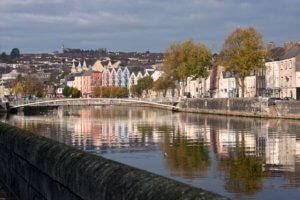Going from Dublin to County Sligo in 10 days seems like a doable trip until you begin to plan it all out.
 This page contains affiliate links and I may earn compensation when you click on the links at no additional cost to you.
This page contains affiliate links and I may earn compensation when you click on the links at no additional cost to you.
There’s a lot of ground to cover, between squeezing in the main attractions that are on offer in Dublin and Belfast, as well as seeing all of Northern Ireland’s incredible coastline and finally making your way across the border to Donegal and Sligo.
While most Dublin to Sligo road trips suggest you travel across the country through Ireland’s midlands, I believe that for first-time visitors to Ireland, a jaunt around the coast is much more adventurous.
Despite the fact that this road trip doesn’t take in the whole of Ireland (it would take several more days, even weeks, to do that), the travel itinerary below is guaranteed to make you want to return to Ireland again.

You can normally fly into either Dublin or Shannon airports or even Belfast if you wish.
If you are flying from the U.K. or mainland Europe, you can fly directly to either Belfast, Cork, Shannon, or Ireland West (Knock) airports.
To be doubly sure, however, check the airline you wish to fly with.
The following airlines maintain service between the U.S. and Ireland: Aer Lingus, American Airlines, Delta, and United Airlines.

Check with each of the airlines to see if they operate flights from the city nearest you.
There are numerous car rental companies at both Shannon and Dublin to provide you with a decent car that will take you on your Dublin to Sligo in 10 Days road trip.
Trying to decide which one to use takes time and often means going on various rental car company websites to get the best deal.

When traveling to Ireland or anywhere that requires a rental car, I first check with Discover Cars. It's easy and you can compare prices easily.
While this trip is obviously geared toward using a car to get around, it’s not always necessary either.
The following is a look at what a Dublin to Sligo in 10 days trip might look like.
DAY 1 & 2 – DUBLIN
Getting into any city after an overnight flight and expecting to do a full day’s worth of sightseeing can be challenging.
After checking into your hotel or B&B, do your best to adjust to the local time by visiting some of the tourist attractions on your itinerary in the afternoon and turning in early for the night.
There’s a lot to see in Dublin. Here are some suggestions as to what you can do over the span of and a day and a half.
The Book of Kells – Trinity College
No visit to Dublin is complete without going to Trinity College to see The Book of Kells.
The infamous Latin script, which was created in the 9th century by monks, documents the four gospels of the New Testament.

While you’re there, be sure to explore the Long Room, which is part of the college’s Old Library, where the Book of Kells exhibit is housed. It contains over 20,000 of Trinity College’s oldest books.
Tickets to the exhibit are between €11 and €28. Children under 12 are admitted free.
Guinness Storehouse Museum
Voted Dublin’s Top Attraction for the past several years, the Guinness Storehouse, located at St. James’s Gate Brewery, is an attraction that most visitors put at the top of their to-do list.
The museum, which is located in what was once the Fermentation House, is the only part of the brewery that is open to visitors.

In fact, the building alone is enough to attract attention. Its central atrium rises seven stories and takes the shape of a pint of Guinness.
Before you get to the seventh floor (that’s where The Gravity Bar is located and where you’ll get fabulous views of the city), visit the museum on the ground floor.

There you’ll discover more about the famous strain of yeast that makes the world’s most famous stout. There are lots of audiovisual and interactive exhibits here, so be sure to take full advantage.
Tip: Don’t miss seeing a copy of the 9,000-year lease that Arthur Guinness signed, which is embedded beneath a pane of glass on the floor of the museum.
Tickets for the Guinness Storehouse experience are €18.50 for adults 18 and over and €16.50 for seniors aged 65 and over.
Dublin Castle
You won’t want to miss this Dublin landmark that has been a part of the city’s landscape since the 13th century. It was built on a site previously settled by the Vikings.
Guided tours include the State Apartments, the Viking Excavation, and the Chapel Royal.

One of the more interesting parts of the castle is the Record Tower, also known as the Wardrobe Tower and Gunner’s Tower. Unfortunately, it is currently closed for restoration and reconstruction. It is expected to be open again by next year.
Dublin Castle puts on a number of interesting exhibitions throughout the year.
The current exhibitions include Vicereines of Ireland: Portraits of Forgotten Women, which is available until Sept. 9, 2021.
Admission to Dublin Castle is €12 for adults, €10 for seniors 60+ and students with a valid ID, and €6 for children ages 12-17. A family ticket is €30. Guided tours are slightly cheaper.
Tip: The Revenue Museum, located in the crypt of the Chapel Royal, is not part of the guided tour, but you can visit it for free if you have the time. There are plenty of audiovisual displays, including a video game for younger visitors. It is open Monday through Friday from 10 a.m. to 4 p.m.
Chester Beatty Library
This is one of the best finds in all of Dublin, and it’s completely free!
The Chester Beatty Library, located behind Dublin Castle, has an extensive collection of artworks from the Western, Islamic, and East Asian cultures.
The library holds the collections of New York mining magnate Alfred Chester Beatty who gifted his collection to Ireland in the 1960s.
Highlights include the finest collection of Chinese jade books in the world, a fascinating exploration of the world’s major religions as shown through decorative and religious art, a collection of Qurans, said to be the best in the world, a rare collection of Buddhist manuscripts, and some of the earliest illuminated gospels in the world from around 200 AD.

Tip: Give yourself plenty of time to visit as there’s so much to see.
Kilmainham Gaol Museum
If you want to learn more about Ireland’s resistance against British rule, a visit to the Kilmainham Gaol Museum is a must.
The building housed some of Ireland’s most famous prisoners, including Robert Emmet, Thomas Francis Meagher, Charles Stewart Parnell, and the leaders of the 1916 Easter Rising.
In May 1916, 14 of them were executed in the prison’s “hard labor yard.”
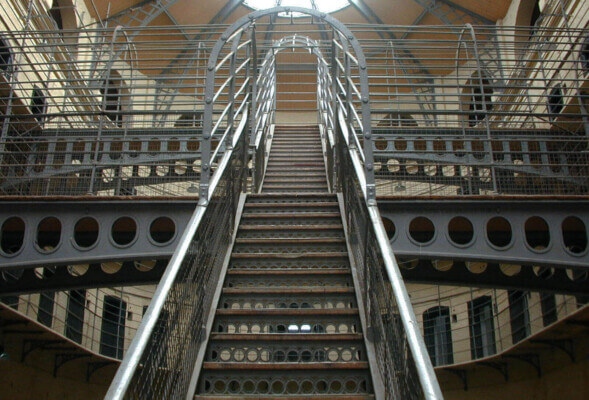
An audiovisual introduction is a good way to get to know the building. That’s followed by a guided tour of the prison, the largest unoccupied building of its kind in Europe.
Tickets are €8 for adults, €6 for seniors 60+, €4 for students 18 and over, as well as children ages 12-17. This tour may not be suitable for younger children due to the subject matter.
Tip: Be sure to purchase your tickets online first. You cannot buy them at the site. Also, wear layers as the prison is cold, even in the summer.
Tours of Dublin
There are plenty of guided day tours to choose from in Dublin.
Accommodation and Entertainment
If you’re on a tight budget, the Generator hostel in Dublin’s city center is a great choice and it’s comfy, too.
The Isaacs Hostel, also in the center of Dublin, is another one that is equally good.

If you’re looking for a budget hotel, don’t forget to check out Kelly's Hotel.
If you are sure you want to stay in the Dublin city center area, be sure to do your research beforehand.
For entertainment, there’s nothing quite like the city’s Temple Bar section.

The most popular pubs there include the Long Hall, a Victorian classic that is one of Dublin’s most beautiful pubs; the Stag’s Head, which was built in 1770 and remodeled in 1895; The Temple Bar, one of the most photographed bars in Dublin; Doheny & Nesbitts, a pub that features antique snugs and other interesting architectural details, and much more.
Read More: How to Save Money on Accommodation in Dublin
DAY 3 – BELFAST
Belfast is an easy drive from Dublin on the M1 motorway as you continue your Dublin to Sligo in 10 Days road trip. The journey takes about an hour and 45 minutes.
Northern Ireland's 40 year-long conflict, known as The Troubles, did a lot of damage to the city, but efforts in recent decades have transformed it into a popular tourist destination.
There are quite a few attractions to be seen in Belfast. The much-visited Titanic Belfast is a very popular one, as are the black taxi tours of West Belfast.
The Titanic Quarter
The area is a hub of activity and is one of the world’s largest urban-waterfront regeneration projects in Europe. It spans over 185 acres and includes Titanic Belfast and a mix of residential and commercial space.
It’s also where many movies have been filmed in recent years, including the HBO hit series, “Game of Thrones.”
The museum is a beautiful tribute to the building of the Titanic and to Belfast itself.
It is storytelling at its best, with nine interactive/interpretative galleries to lead the visitor from one section to another.
If you’ve got the time, check out the other attractions in the Titanic Quarter. They include the SS Nomadic, the last remaining vessel of the White Star line. You can visit the ship with your admission ticket from Titanic Belfast.

There are various experiences available at the museum, including the Titanic Experience, which is the self-guided tour, the White Star Premium Pass, the Discovery Tour, and the Afternoon Tea experience.
Tip: Be sure to visit the SS Nomadic, often referred to as the “little sister” of the Titanic.
Tickets start at £19 for adults. Read the more than 22,000 reviews that TripAdvisor fans have documented about their experience at this iconic Belfast attraction.
Black Taxi Tour of West Belfast
There are several tour companies that will take you through the Falls Road and Shankill Road neighborhoods of West Belfast. One that I recommend is a company called Belfast Tours.
You’ll get a fascinating view of working-class Belfast, where murals are commonplace, both to heroes of the Catholic side of the conflict and to those of the Protestant side.

Both neighborhoods are only a few blocks away from each other. The entrance to them is accessed through a steel gate, which is open during the day and closed at night.
A frequent stop on many black taxi tours is Bombay Street, where, in 1969, a Loyalist gang burned the homes of 1,500 Catholics. The victims’ photos are part of a mural in this neighborhood, along with a separate memorial.

While there are several peace dividers all across Belfast, the most famous one stretches for about half a mile and contains the signatures of President Bill Clinton, the late South African President Nelson Mandela, and others.
Tip: It’s ok to ask the driver to stop if you’re curious about certain aspects of the route. Most of them are very accommodating and are open to answering questions.
Belfast Tours charges £40 for the first two people and £17.50 for each additional passenger.
Read reviews of the tour from TripAdvisor fans.
Tours of Belfast
If seeing Belfast with the help of a tour guide is more to your liking, there are several to choose from. They include Belfast City Tours, Belfast Hidden Tours, and Cityseeing Belfast.
Accommodation and Entertainment
Like Dublin, there are ample opportunities for nightlife in Belfast, depending on what’s your fancy.
If it’s a traditional pub you’re looking for, you should stop at the Crown Liquor Saloon on Great Victoria Street.

During the Troubles, the bar was bombed several times by the IRA, giving it the reputation of being the most bombed pub in Europe.
Today, it has been restored to its original glory, thanks to the renovation efforts of the National Trust.
The floor’s original mosaic tiles are still there, as well as the red granite-topped bar, the decorative ceiling, and the gas lamps that hang from it.
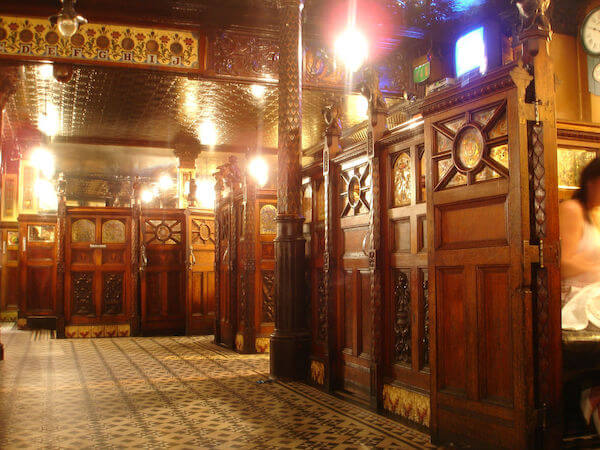
The pub also has 10 snugs equipped with gunmetal plates used for striking matches, along with an antique bell system.
Other popular drinking holes in Belfast include the Perch, a lively rooftop bar in the city’s historic Linen Quarter; Kelly’s Cellars, Belfast’s oldest pub where you can enjoy traditional Irish music sessions; and the Duke of York located in the Cathedral Quarter.

There are many hotels to choose from in Belfast.
The Malmaison Hotel is a boutique hotel located on Victoria Square. Its décor is inspired by the Titanic. It is centrally located and pretty much close to everything, including shopping, restaurants, nightlife, and more.
The Vagabonds Hostel is one of the best in Belfast, and the price is pretty good, too.
A superior double room is £50 per night and a superior two-bed twin room is also £50. Rooms catering to larger groups are cheaper, starting at £18 per person. All rates include free breakfast and free tea or coffee all day.
Take a Guided Day Tour from Belfast
DAY 4 – THE CAUSEWAY COAST
Leaving Belfast on Day 4 and driving north to Portrush will give you the opportunity to experience the beauty of Northern Ireland, in particular, the Causeway Coastal Route, which begins in Belfast and ends in Derry.
This is one of those not-to-be-missed regions of the island of Ireland that will form part of your Dublin to Sligo in 10 days trip.
About 12 miles from Belfast is the town of Carrickfergus, which is located on the shores of Belfast Lough.
Stopping at Carrickfergus Castle is well worth it, not just because it’s free to visit but because it is one of Ireland’s best-preserved Anglo-Norman castles. Its history is fascinating, too.

For more than 750 years, it has survived a string of military occupations. No doubt it was because of the castle’s strategic position that the Scots, French and English tried to attack it over the years.
About an hour north of Carrickfergus, still on the Coastal Causeway route, is the pretty seaside village of Cushendun, which is nestled at the foot of Glendun, one of the nine glens of Antrim. The town, a designated conservation area, was designed to look like a Cornish village.

While there, take a walk to the Cushendun Caves, featured in many scenes from “Game of Thrones,” and afterward have a bite to eat in Ireland’s smallest pub, Mary McBride’s Pub. The pub has earned the TripAdvisor Certificate of Excellence for the past three years.
Drive an hour and 56 minutes and you’ll reach Portrush, known as the “fun capital of the Causeway Coast.”
This is a good place to stay for the night as it’s close to several attractions, including the Giant’s Causeway, the Carrick-a-Rede Rope Bridge, and Bushmills Distillery.
Get Wifi While Traveling in Ireland – take 10% off with code IOB2024
DAY 5: PORTRUSH AND SURROUNDING AREA
This is an equally pretty seaside resort that has three Blue Flag beaches, which are also known as surfing meccas.
If you have the time, take a stroll along its Main Street and enjoy the shops, bars, restaurants, and arcades that are there, as well as the iconic White House store that has been in the village for the past 120 years.

The town is also home to the Royal Portrush Golf Club, where the British Open was recently played.
Otherwise, head to the area’s two main attractions, the Giant’s Causeway and the Carrick-a-Rede Rope Bridge.
The Giant’s Causeway
These world-famous basalt columns are among Northern Ireland’s top attractions.
While they were actually formed as a result of a volcanic eruption that took place millions of years ago, legend tells a different story.

The tale is that the Irish mythological hero/giant Finn MacCool was challenged to a fight by the Scottish giant, Benandonner.
Finn accepted the challenge and decided to build a bridge, a giant’s causeway, across the North Channel that would lead him to Benandonner.
However, after taking one look at the giant, he retreated. Finn’s wife, Una, came up with the idea of dressing Finn as a baby and putting him in a cradle.
When Benandonner spotted the huge child, he assumed the baby’s father, Finn, was even bigger and ran back across the causeway to Scotland, destroying the causeway and leaving Finn unable to reach him.
While you're there, look out for the curious-looking rock formation called the “Giant’s Boot,” the “Wishing Chair,” and “The Camel,” a rock formation that looks like a camel’s hump.
Tickets are a little cheaper if you book them online. Adult admission is £11, a children’s ticket (5+) is £5.50 and for families of 3, 4, or 5, the admission is £27.50. Children under 5 are admitted free.
Tip: You don’t have to pay to see the Giant’s Causeway. However, if you are interested in the guided tour, you must pay the fee. Visitors who are not paying the fee are being asked by the National Trust to not park in the attraction's designated parking lot.
Carrick-a-Rede Rope Bridge
This popular attraction is about a 15-minute drive from the Causeway.
The rope bridge connects the mainland with the tiny island of Carrickarede. The bridge spans 66 feet and 98 feet above the ocean.

It was first built by salmon fishermen 350 years ago.
This is a must on any tour of Northern Ireland unless you have a fear of heights.
A timed ticketing system is in place. Go to the website to order tickets.
Read More: Game of Thrones Studio Tour Opens
Accommodation and Entertainment
There’s plenty of accommodation to choose from in Portrush, including B&Bs and hotels. If budget is a concern, the Portrush Holiday Hostel is an excellent choice. Rates are from £15 per night.

Rates at the Royal Court Hotel are from £75 per night. This traditional hotel, a TripAdvisor Certificate of Excellence winner, is in a beautiful location overlooking the Whiterocks beach and the golf course.
If you’re looking for a lively night out in Portrush, head to Kelly’s Complex, which includes five bars and three dance floors. It is one of Northern Ireland’s hottest nightclubs.
If you're looking for something a little more traditional, try The Harbour Bar right by the harbor in Portrush. You'll find traditional Irish music sessions and a warm fire if it's chilly outside. There's also food available.
DAY 6: BUSHMILLS DISTILLERY, DUNLUCE CASTLE
Before embarking on your 45-minute drive from Portrush to Derry be sure to stop at the Old Bushmills Distillery.

A guided tour includes a history of the distillery and at the end, you can enjoy tutored tastings in the 1608 Bar.
Tickets are £9 for adults, £8 for seniors 60+ and £5 for children aged 8-17. Tickets for a family of five, with children aged between 8 and 17, is £25.
Read More: Oldest Whiskey Distilleries in Ireland (including The Bushmills Distillery)
Dunluce Castle
This is a popular stop with coach tours, and it’s easy to see why. Dunluce Castle perches, precariously it seems, on a cliff from where you can get a commanding view of the Northern Ireland coastline and beyond.

It was once the home of the Clan McDonnell of Antrim.
The story goes that part of the castle’s kitchen fell into the sea one stormy night and that following the catastrophe, the owner refused to live in it. However, the kitchen is still intact and if you take a tour of the castle, you’ll see the oven, fireplace, and entryways that lead into it.
Tickets cost £5 for adults and £3 for children.
Plan on arriving in Derry by early evening.
DAY 7: DERRY
The city of Derry, also known as Londonderry, is the second-largest city in Northern Ireland.
Like Belfast, it has also been the site of much violence in the past. But that doesn't mean that you should take it off your list of places to visit on your Dublin to Sligo in 10 days journey.

Today, it is a popular tourist destination and the gateway to the Republic. This should be the seventh day of your Dublin to Sligo in 10 Days road trip if you are strictly keeping to this itinerary.
Derry City Walls
Derry is the only completely walled city in Ireland and one of the best examples of a walled city in Europe.
Its 17th-century walls were built as a defense system for the English and Scottish who settled there in the 1600s.
They form a walkway around the inner city and from the top, you can get an amazing view of the layout of the original town, complete with its Renaissance Street plan.

There are seven gates in all. They include the original four, which are Bishop’s Gate, Ferryquay Gate, Butcher Gate, and Shipquay Gate. The other three were added later and include Magazine Gate, Castle Gate, and New Gate.
Along the walk, you’ll encounter a number of cannons, including an iconic one called “Roaring Meg” that made a very loud noise when discharged.
The entire walk is just over a mile and takes about an hour to complete. The walls are free to visit.
Tip: If you want to get a real sense of the history of Derry and the role that the walls played in the evolution of this city, head to the Visitor Information Centre where you can join a free tour.
The Guildhall
This neo-Gothic style building is where elected representatives of the Derry and Strabane District Council currently meet.

It was opened in 1890 and was originally called “Victoria Hall.” The interior of the building is quite beautiful, with stunning stained-glass windows, a grand staircase, a large organ in the building's main hall, and stately corridors.
An exhibition exploring the Ulster Plantation and how it shaped this part of Ireland is worth seeing, and interpretative panels throughout the building really bring the history of Derry to life.
The Guildhall is free to visit.
Tip: Guided tours are available, but you must request them in advance. Email [email protected]
St. Columb’s Cathedral
This is Ireland’s oldest surviving building. It is dedicated to St. Columba, the Irish monk who established a Christian settlement in the area.
St. Columb’s was the first cathedral to be built by the Anglican church after the Reformation. It was also the first non-Catholic cathedral to be constructed in Europe.
It is considered Derry’s most historic building, housing portraits of William of Orange and the original keys of the city.
Admission is free.
Tip: Click this link to download the cathedral app on your smartphone.
Tower Museum
This museum is well worth a visit and explains the political conflict that has shaped Derry as well as its ancient history.

Located in a 16th-century tower house, there’s much to learn and see here. Stop at the Armada Shipwreck and Story of Derry exhibitions.
Expect to spend two hours here as there is much to take in. Read some of the reviews from TripAdvisor fans here.
Tip: If your ancestors came from Derry, this museum may be of particular interest. Its Archive and Genealogy Service has partnered with the Irish Family History Foundation to gather important data. More information can be found at www.derry.rootsireland.ie.
The Bogside
No visit to Derry is complete without visiting the Bogside, the staunchly Catholic neighborhood of the city and a predominantly working-class community.
It shares a border with the Protestant enclave, known as the Fountain.
Most tourists are drawn to the murals painted on the community's large gable walls depicting Catholic nationalist heroes.
In 1969, the area was the center point of a three-day standoff called the Battle of the Bogside, which signified the start of the Troubles in Derry.

Bogside History Tours provides excellent tours of the area for around £12. See some of the positive reviews this TripAdvisor Certificate of Excellence provider has gotten.
The one-hour Free Derry Tours includes visits to the People’s Gallery murals, the Free Derry Corner Corner, the Hunger Striker’s Memorial, as well as the Bloody Sunday Memorial.
Tip: It’s best to see the Bogside with the help of a tour guide.
Depending on how much time you have, there are other sites to be seen in Derry, many of which are covered by City Walking Tours, a family-owned, budget-friendly walking tour of the city that has earned lots of great reviews on TripAdvisor.
Read More: Derry Girls Tour: Seeing Derry Through the Eyes of “The Derry Girls”
Accommodation and Entertainment:
While there are many options to choose from when it comes to accommodation in Derry, you won’t go wrong with these picks.
If you want to step back in time, you should check out the following properties that are located in the oldest and most historic section of the city. They are all owned and managed by Peter and Joan Pyne.
They include the Merchant’s House, a Georgian-style townhouse that was built over 150 years ago for a naval surgeon and has received rave reviews on TripAdvisor. Its rich architectural details can be seen throughout the home.

They also manage Saddler’s House, a Victorian townhouse that was built in 1871 for William Dickson, Esq., a saddle maker. The home retains much of its original architectural features and includes beautiful period furniture. It has received equally glowing reviews.
The owners also have three self-catering/vacation rentals in older buildings. They include Cathedral Cottage, Darcus Cottage, and the Pump House apartments.
If you’re looking for some entertainment in Derry, look no farther than Peadar O’Donnell’s, the quirky pub that dresses itself up as a grocery store complete with household items, a shopkeeper’s scales, and other bric-a-brac.

You’ll get a great pint of Guinness at O’Donnell’s and the chance to hear traditional music during the week and at the weekends.
While you’re there, head next door to the Gweedore Bar, where live rock bands and traditional musicians also play.
The Grand Central Bar, a favorite with locals for close to 100 years, still maintains its original décor. Located on the popular Strand Road, you’ll not only get a drink there, the food is pretty decent as well.
If you’re looking for a trendier spot, stop at the Walled City Brewery, the only brewery/restaurant combination on the island of Ireland. It was recently voted the “Best Pub in the North.”
DAY 8: DONEGAL
Donegal is a truly beautiful county and is often overlooked by tourists more eager to see Ireland’s more popular attractions.

But don’t discount this place. Once you’ve visited Donegal, you’ll want to return again and again.
Much of the county is unspoiled. There are a few big towns, but most of the charm is to be found in Donegal’s out-of-the-way spots located along Ireland’s Wild Atlantic Way.
Be sure to spend some time in this beautiful place on your Dublin to Sligo in 10 days road trip.
Glenveigh National Park
While it would be tempting to take the 33-mile drive from Derry north to the gorgeous Malin Head (Ireland’s most northerly point), it would take quite some time out of your day so I’m suggesting that you drive the 35 miles or so west to the equally beautiful Glenveagh National Park.
As Ireland’s largest national park, it covers a total of 40,000 square miles of mountains, lakes and natural woodlands. It can be found in the heart of the Derryveagh Mountains.

The park includes Glenveagh Castle, a castellated 19th-century mansion, as well as the castle’s Victorian gardens.
If you want to cycle around the park, you can rent an electric or hybrid bike from a local company called Grass Routes. You can rent out a bike for three hours or the whole day. The cost to rent an electric bike is €18 and a traditional bike is €12.
The rental company is located in the main parking lot from 10 a.m. to 5 p.m. Rentals are available from mid-June through September.
Glenveagh Castle is open from March through October for guided tours. Admission for adults is €7 and €5 for seniors, students with valid IDs, and children over 6.
Tip: You cannot park close to the castle. You must either walk or take a short bus ride. The cost is nominal at €3 for a round-trip ticket.
The Poisoned Glen
As you head west, don’t miss the Poisoned Glen, which lies at the foot of Mount Errigal.

The now ruined Dunlewey Church of Ireland stands at the center of this magnificent valley. It was built as a memorial to James Russell, the landlord of the Dunlewey estate.
This is a truly magnificent spot. Be sure to take plenty of pictures.
Horn Head, Tramore Beach
Head north toward Horn Head. As you drive through this region, you’ll be inspired by the scenery and views of Donegal’s many islands, as well as Malin Head, the Rosquil Peninsula, even Scotland.

If you can imagine yourself galloping the 2-mile stretch of Tramore Beach on a horse, then stop by Dunfanaghy Stables. The well-known riding school provides short rides for children and adults, as well as longer trail riding and horse-riding sessions.
Adult rides cost €32 per hour and children under 18 are €27 per hour. Hour-hour lessons for children are €15, while half-hour lessons for adults are €18. More information can be found on the Dunfanaghy Stables website.
Tip: There are several walks you can take in this area, including the Horn Head Walk, the Muckish Railway Walk, and the Famine Graveyard Walk.
Slieve League Cliffs
Drive the 65 miles south to the Slieve League Cliffs (pronounced “Schleeve”) and I promise you won’t be disappointed. These are the highest cliffs in Ireland, three times higher in fact than the Cliffs of Moher in Co. Clare.
From the top, you’ll get magnificent views of the surrounding area, including Donegal Bay and neighboring County Sligo in the distance.

If you’re scared of heights, the safest place to take in the magnificent view is from the Bunglass Viewing Platform (close to the Slieve League Visitor Center).
You can, however, take the path that leads from there up to the cliffs for a more magnificent view.
For the more adventurous, the One Man’s Pass or the Pilgrim’s Path, both of which will take you to the summit, are worth the effort.
Tip: If you decide to take the more arduous hikes, dress appropriately and bring plenty of water.
Read More: Donegal Tour Guide: Meet Henry Doohan
Accommodation and Entertainment
After a long day of touring and exploring Donegal’s beautiful coast, finding a decent play to stay shouldn’t be a chore.

The Slieve League House B&B is the perfect place to unwind. This B&B has several rooms with en-suite bathrooms, free Wi-Fi, and parking. A hearty Irish breakfast is served in the morning.
Nightly rates at this popular B&B during the summer average $100 for two people.
The nearest pub is called John the Miner’s Central Bar, where you’re sure to hear a traditional Irish music session. It’s just over a mile away in nearby Carrick.
Read More: Take a Cruise Along the Donegal Coastline with Atlantic Coastal Cruises
DAY 9: SLIGO
County Sligo is generally known as Yeats Country and to be sure, the famous poet has most definitely influenced the town and the county from a tourism perspective.

But there’s a lot more to Sligo than that.
If you’d like to return to Sligo or simply feel like you need more time there, check out this blog post on taking a road trip across Sligo.
Start your day in Sligo with a free walking tour of the town. Join the other walkers taking the tour at the Tourist Information Office on O’Connell Street.
Tours are offered Monday through Saturday at 11 a.m.
The walk is approximately 4.5 kilometers (2.79 miles) and will take you to the town’s most significant historical sites.

Places of interest include the Cathedral of the Immaculate Conception, which opened in 1874, which contains 69 stained-glass windows, and St. John’s Church, the Church of Ireland cathedral, where Yeats’ parents were married.
In the nearby churchyard, you’ll come across the burial site of Charlotte Mathilda Blake Thornley, the mother of Bram Stokers, the author of “Dracula.”
Tip: Don’t miss the marker on Old Market Street (once called Correction Street) that designates where Bram Stoker’s mother was born and lived.
Sligo Abbey
Perhaps the most well-known of Sligo attractions is The Abbey, the only medieval structure still standing in the town. Sligo Abbey is a burial place of kings and princes, including the King of Briefne, who died in 1418, and successive chiefs of the ruling O’Conor clan.

Admission is €5 for adults, €4 for seniors and groups, €3 for children and students, and €13 for a family.
Tip: If you’re up for a good ghost story, learn more about the abbey on the Sligo Dark Tales Tour.
Yeats Memorial Building
This is the headquarters of The Yeats International Summer School, which invites students and professors from around the world to visit Sligo and immerse themselves in a cultural and literary experience based on Yeats’ work.

You can also find out more about Yeats and his brother, Jack B. Yeats, the painter, at the Sligo County Museum and Niland Gallery located on Stephen Street, which houses a collection of photographs, letters, and newspaper cuttings on the family.

If you’re interested in seeing Irish art, including the works of Jack B. Yeats, you’ll want to check out The Model, which was built in 1862.
Tip: The Model has exhibitions from other Irish painters, too, as well as frequent music performances. See what’s on now.
North of Sligo – WB Yeats’ Grave/Drumcliff
Take a 9-minute drive north from Sligo on the N15 and you’ll find yourself in Drumcliff, the burial place of Yeats.

The church in Drumcliff is called St. Columba’s Church, a parish church belonging to The Church of Ireland, where Yeats’ great-grandfather was once a rector.

Before he died in 1939, the poet asked to be buried in this peaceful spot. The tombstone is the main attraction, with a round tower and a high cross nearby.
The words inscribed on the stone are from his poem, “Under Ben Bulben.”
It is free to visit.
Tip: See if you can find the camel on one of the high crosses in the graveyard at Drumcliff. This particular one is highly decorated.
Lissadell House
An 11-minute drive will take you to a delightful place called Lissadell House, the former home of the Gore-Booth family, including the revolutionary nationalist Constance Gore-Booth (otherwise known as Countess Markievicz).
The grand mansion is now privately owned by a Dublin couple who have lovingly restored it over the past few years.

Open from April through October, the house is a Greek Revival-style structure that was built between 1830 and 1835. It was the last one of its style to be built in Ireland.
The country house is located on the shores of the Magherow peninsula overlooking Drumcliff Bay.
Guided tours of the house are 45 minutes long. They include access to the billiard room, the gallery, the anteroom, the drawing-room, and the dining room.
The tour also includes the servants’ quarters downstairs.
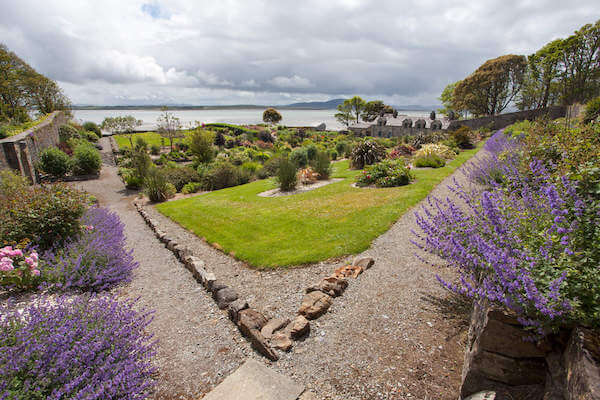
Admission for adults is €14, €6 for children ages 5 and over, €12 for seniors and students, and €36 for a family of four.
Prices include the guided tour, entry to the current exhibitions at Lissadell, admission to the Alpine Garden and the Victorian Garden, as well as to the house, and the Woodland Walks.
Tip: Take time to explore the estate’s Alpine Gardens, where you’ll find an abundance of unusual flowers and plants. The view over Sligo Bay is breathtaking.
Accommodation and Entertainment
Sligo has a multitude of options when it comes to accommodation, all of which are affordable for a one-night stay.
The Glasshouse Hotel is situated right in the center of Sligo, which makes it very accessible to restaurants, pubs, and various attractions around town.

The cool-looking hotel with a glass façade has over 100 rooms that are brightly decorated. The hotel also includes a restaurant and two bars.
The Railway Hostel is also in town and a great pick if you’re on a tight budget. The Victorian-style building was constructed in 1886 and is on the list of Sligo’s protected properties.
Rates are extremely competitive. Mixed dorm rates are €18 per night. A twin room is €22 per person and a double room (with two larger beds) goes for €25 per person. A room for a family of six is €80.

If you’re willing to go out of town a bit, the Sligo Park Hotel is another great choice. The hotel has a host of beautiful rooms as well as a leisure center, equipped with a pool and gym.
For entertainment, Sligo has many excellent pubs.
One of them is the old-style Hargadon Bros., which has been a part of Sligo since 1864.
Originally a grocery store that sold beer, wine, and spirits, today Hargadon’s is a popular spot for a pint and some grub.
Much of the food at Hargadon’s is sourced from local providers, including its fruits and vegetables, as well as the beef, lamb pork, and fish that make up its lunch and dinner menu.

Another great Sligo drinking hole is Thomas Connolly’s Pub. It is one of the oldest traditional pubs in Ireland’s northwest, having received its liquor license in 1861.
The pub is on the Irish Whiskey trail and is home to an impressive collection of over 60 premium whiskeys, including Irish, Scotch, and Bourbons. You’ll also find traditional music sessions at Connolly’s.
A definite must-see if you love whiskey.
DAY 10: RETURN TO DUBLIN
You'll have finished your Dublin to Sligo in 10 Days road trip at this stage.
Even if you don't do exactly everything on this itinerary, there should be enough activities included, as well as ideas on accommodation, to get you thinking of a similar trip around the Emerald Isle.
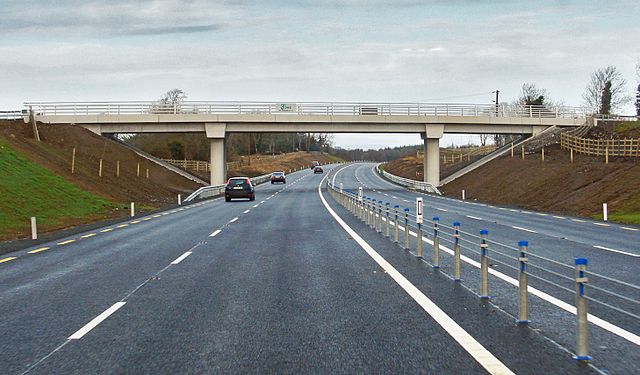
The return trip to Dublin from Sligo should take about 2.5 hours. The N4 motorway to Dublin is well signposted and easily accessed from Sligo town.
Are you planning a trip to Ireland soon? Maybe a Dublin to Sligo in 10 days road trip is part of your itinerary. If so, let me know in the comments below.
As always, if you haven’t signed up for my regular e-newsletter, please do so below.



